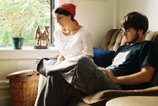

BRIGHT IDEAS
Coloring Outside the Lines
My old home in Ohio seems to thrive with children these days: nieces and nephews now, who fill the old space with new worlds and clear sounds. Walter Benjamin tells us that “because children see with pure eyes . . . it is something spiritual. Children are not ashamed, since they do not reflect what they see.” They do not need yet to fit their experiences into categories of feeling and judge them moral or not like Kant, so each experience, each imagination is brand new and full all the way down. They can paint like Edvard Munch and Paul Klee without knowing, they can burn their way through classic literature without interpreting.
Our friend Oliva tells us that “the only reason we give things to children is so we can borrow a bit of their joy.” We take children to the zoo to watch them enter animal worlds, we give them baby puppies so they can enact free-form cuddling and other slightly inhumane stunts, we give them small blankets which they call “bweebies” or some such thing so we can enjoy watching them stroke the special corner on their faces and protest any infringement of their ultimate property. We tell them stories which they take to be true and true absolutely. It’s enchanting in its simple sympathetic magic: dams in a creek like a hyrdrologist, tee-pees in the backyard like a wildman, barnyard noises, and wrestling matches for cheering spectators like little men; and we give ourselves over to it hoping a little piece of it will sink into our own souls.
The Chinese word for experience, jingyan, implies a test of woven fabric which produces a warp or fraying. For the Chinese, experience, produces an object and a subject that has been changed by time. Last weekend I spent 20 minutes looking at hand tools at an Amish hardware store thinking about my friend Harlan who restores thrifted Old World chisels and planes hoping that authentic work will offer a trace of meaning, will give up a space for telling the story of the tinker, the weaver, the scraper and carver. He handles his tools like a child with precious toys rescued from rusty trash and the world of plastic. One time when Harlan’s daughter Eve (the mother of nature I guess in Hebrew) was smaller than she is now he told me that he wonders at what she is seeing in her yet un-reflective eyes. I imagine it was something like what the Surrealist Franz Hessel said about the philosophy of the flaneur: “We see only what looks at us. We can do only . . . what we cannot help doing.” This is what children are good for: giving newness and grandeur to the mundane, showing us objects wrapped in stories back their truth.







1 Comments:
wow--those curls are just adorable. great pix.
Post a Comment
<< Home